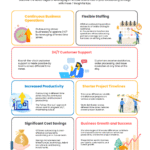In an ever-globalizing business landscape, navigating cultural diversity in the workplace has become a crucial skill for companies and managers alike. Diversity and inclusion are no longer just buzzwords—they are essential components for innovation, employee engagement, and corporate success.
Experts have long highlighted that a culturally diverse workforce can enhance creativity, provide valuable insights into local markets, and drive profitability. Nonetheless, it requires a nuanced approach to harness the full potential of a multicultural team.
What is cultural diversity?
Cultural diversity encompasses the multitude of differences among people in an organization. These differences can include language, traditions, values, and perspectives that individuals from different backgrounds bring to the table. It’s an amalgamation of every employee’s unique attributes and life experiences.
Evidencing the richness of human culture, diversity is not just about nationalities but also about the diversity of thought. It’s the variety of solutions, ideas, and creativity that spawn from a group of people with heterogeneous backgrounds working together.
When embraced, cultural diversity leads to a more dynamic and innovative workplace. It can be the catalyst for growth and learning, not just for the business but for its individuals as well.
Why is cultural diversity important in the workplace?
The importance of cultural diversity in the workplace lies in its ability to foster innovation and drive business growth. Diverse teams often outperform their homogenous counterparts due to a wider range of experiences and perspectives that spur creative thinking.

Cultural diversity also allows companies to resonate with a broader customer base, making them more competitive in the global market. It provides a deeper understanding of different demographics, which can lead to better-targeted products and services.
Furthermore, a commitment to diversity can enhance a company’s image, making it more attractive to top talent who value inclusivity and equal opportunity.
How can managers navigate cultural differences?
Managers play a critical role in creating an inclusive environment where cultural differences are seen as assets rather than obstacles. They can start by fostering open communication and encouraging employees to share their cultural experiences and perspectives.
Training programs focused on cultural competence can equip managers with the tools to understand and empathize with different cultural norms. This leads to better conflict resolution and a more cohesive team.
It’s also essential for managers to lead by example by demonstrating respect for all cultures and avoiding any form of cultural stereotyping.
Lastly, acknowledging cultural holidays, dietary restrictions, and language barriers by providing appropriate accommodations can go a long way in making all employees feel valued and included.

What are the benefits of a culturally diverse workplace?
- Enhanced creativity and problem-solving due to a mix of different perspectives and approaches.
- Better understanding of target markets and customer needs, leading to improved product offerings and marketing strategies.
- Attracting and retaining top talent is more feasible when the work environment is known for its commitment to inclusion and diversity.
- Improved decision-making as diverse teams are less prone to groupthink and more likely to consider a wider range of options and potential outcomes.
Companies like L’Oréal have leveraged cultural diversity to gain a competitive edge in the beauty industry, customizing products to meet the needs of diverse consumer bases across the globe.
What are the challenges of cultural diversity in the workplace?
While the benefits of a culturally diverse workplace are significant, the challenges can be equally daunting. Communication barriers, cultural misunderstandings, and resistance to change are but a few of the hurdles that companies may face.
Overcoming these challenges often requires a tailored approach to training and the implementation of inclusive policies. It also calls for a leadership team that is committed to fostering an environment where every employee’s voice is heard and valued.
Unconscious biases and stereotypes can hinder the integration of a diverse workforce. Hence, organizations must proactively identify and address these issues to create a truly inclusive culture.
How to promote cultural diversity and inclusion at work?
To effectively promote cultural diversity and inclusion, organizations should start by conducting cultural awareness training to educate employees about unconscious biases and the value of diversity in the workplace.
 Diversity and inclusion in the workplace: benefits and how to promote them
Diversity and inclusion in the workplace: benefits and how to promote themBuilding employee resource groups can provide support networks and help underrepresented groups have a voice in the workplace. It also involves revising recruitment practices to ensure a diverse talent pool is being considered for every role.

Implementing flexible policies that respect cultural differences, such as allowing for different holiday observances, can also demonstrate an organization’s commitment to inclusivity.
Regularly reviewing internal policies and practices to ensure they support diversity and inclusion is crucial. This may involve examining everything from hiring practices to performance evaluations and promotion criteria.
What are key strategies for navigating cultural diversity?
Some key strategies for navigating cultural diversity include active listening, educating oneself about different cultures, and promoting open dialogue about cultural differences. Managers should also be neutral and non-judgmental, creating an environment where all employees feel comfortable expressing themselves.
Incorporating diverse cultures into organizational practices, such as celebrating cultural days or recognizing significant events, can also be a powerful way of showing respect and appreciation for cultural diversity.
Understanding cultural dimensions, such as those outlined by Hofstede, can provide managers with a framework for understanding cultural differences and how they may affect workplace dynamics.
For a deeper dive into this topic, have a look at this insightful video on navigating cultural diversity in the workplace:

Frequently addressed questions on cultural diversity in the workplace
How to navigate cultural differences in the workplace?
To navigate cultural differences effectively, it’s important to encourage a culture of openness and respect. Employees should be urged to share their cultural backgrounds and experiences. This helps to build mutual understanding and appreciation within the team.
Providing opportunities for cross-cultural interactions, such as through team-building exercises or cultural exchange programs, can also help employees to experience and understand different cultural perspectives firsthand.
What are the 4 principles of cultural diversity?
The four principles of cultural diversity are awareness, acceptance, appreciation, and accommodation. Awareness involves recognizing the various cultural backgrounds of employees. Acceptance means understanding that these differences are valuable and should be respected.
Appreciation goes a step further, involving active efforts to celebrate cultural diversity. Accommodation is the commitment to making changes in the workplace that respect and cater to the diverse needs of all employees.
What are the 7 strategies for driving cultural awareness in your workplace?
Seven strategies to drive cultural awareness in your workplace include:

- Implementing diversity training programs.
- Creating diverse project teams.
- Encouraging the celebration of cultural events.
- Facilitating language learning opportunities.
- Developing inclusive policies and practices.
- Offering support through employee resource groups.
- Engaging in community outreach programs.
What steps can you take to understand cultural diversity in the workplace?
Understanding cultural diversity in the workplace begins with self-education. Managers and employees alike should learn about different cultures and their potential impact on work styles and communication. Additionally, seeking direct feedback from employees about their cultural needs and preferences is key.
Organizing regular discussions or workshops on cultural topics can also provide ongoing learning and engagement for all team members. It’s about creating a workplace where every individual can contribute to their fullest potential, regardless of their background.
By addressing these questions and incorporating strategies to manage cultural diversity effectively, organizations can create a vibrant, inclusive, and high-performing workplace that is well-equipped to tackle the complexities of a global business environment.
 Time zone advantages: how remote work bridges Latin America and the U.S.
Time zone advantages: how remote work bridges Latin America and the U.S.







